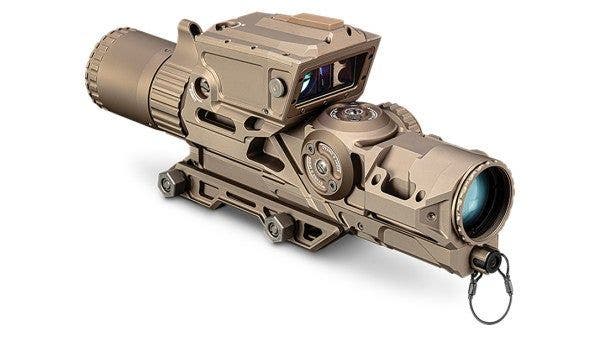
Starting this year, the U.S. Army will embark on a massive overhaul of its infantry equipment. Soldiers will be equipped with new, state-of-the-art rifles and automatic infantry weapons, including a new rifle scope that uses a laser and a miniaturized computer to predict the path of a bullet depending on range.
There are many factors that can affect a bullet’s trajectory, including air resistance, angle, air pressure and temperature, muzzle velocity, bullet shape, and drag coefficient. All of these factors will determine the accuracy of the bullet hitting the desired target. However, the most important factor is gravity, which pulls down the bullet, followed by wind speed and direction.
The farther away a target is, the stronger the effects of gravity and wind become, depending of course on the caliber of the projectile. For instance, an M855 5.56-millimeter round firing from a standard Army M4 carbine will impact nearly 13 inches lower and eight inches farther in the direction of wind travel at 300 meters than it will at 100 meters.
Trained snipers often use charts and tables to compensate for bullet drop, but it can take hundreds of hours of practice to get good enough to fire accurately at distant targets. Some modern add-on optics have built-in bullet drop compensators, but the operator still has to manually make adjustments. This is where the new computerized rifle scope developed by Wisconsin-based Vortex Optics comes in.
This scope effectively predicts the path a bullet will take towards a target at a variable range before the operator pulls the trigger. The technology is not that different from the kind used by tanks to accurately hit targets more than a mile away. A modern tank has ranging lasers that can instantly measure the distance to a target with an error in the centimeter range. They also have sensors that detect the speed and heading of the wind. A ballistic computer crunches this data and, depending on the tank turret and ammunition, instructs the tank gunner where to aim to hit his target.
The tank ballistic system is extremely cumbersome and can weigh hundreds of pounds. But Vortex Optics managed to squeeze virtually the same technology into the size of a rifle scope, called Next-Generation Squad Weapons—Fire Control (NGSW-FC). According to the company, the new sighting device can provide between 1x and 8x magnification and an “active reticle fire control system” that gives the user an adjusted point of aim that compensates for bullet drop and wind direction. There are also wireless features in order to provide a picture-in-picture display of the weapon sight to the still-developing Integrated Visual Augmentation System, a mixed reality headset that allows soldiers to overlay 3D maps in their field of view or switch to thermal and low-light vision, among many other things.
“The NGSW-FC system is a ruggedized fire control that increases accuracy and lethality for the Close Combat Force. It integrates a number of advanced technologies, including a variable magnification optic, backup etched reticle, laser rangefinder, ballistic calculator, atmospheric sensor suite, compass, Intra-Soldier Wireless, visible and infrared aiming lasers, and a digital display overlay,” according to a release from the Army’s Cross Functional Team-Soldier Lethality.
NGSW-FC can be attached to the standard M1913 Picatinny rail, making it compatible with most NATA and U.S. Army rifles. However, it is meant to be equipped in the upcoming Next-Generation Squad Weapons—Rifle (NGSW-R) and Next-Generation Squad Weapons—Automatic Rifle (NGSW-AR), which steadily replace the Army’s existing M4 carbine and M249 squad automatic weapon. Starting with 2022, the Army will purchase at least 100,000 of these next-generation rifles manufactured by three companies: Sig Sauer, General Dynamics Ordnance, and Textron Systems . Troops like special forces, Army Rangers, combat engineers, and rapid-response light infantry will be the first to get their hands on them.
According to Army Times, Vortex Optics has been awarded a $2.7-billion contract to deliver 250,000 computerized auto-aiming scopes. The contract also includes training, contractor support, spare parts, repairs, and engineering efforts.









